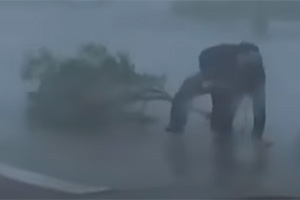
You may not have heard of him, but John Selden made a lot of very profound statements. Selden was an English scholar who lived from 1584 until 1654, and among his many sayings is, “Ignorance of the law excuses no man.” Over the centuries, highway patrolmen, judges, and others in positions of power have popularized the phrase as, “Ignorance of the law is no excuse.” Selden also wrote a special idiom about hypocrisy, which he used when chastising preachers, and politicians who behaved one way but held everyone else to a different standard. Selden mocked their hypocrisy by saying, “Do as I say and not as I do.” Were John Selden alive today and had he watched coverage of hurricane Ian on TV, he would have certainly aimed his hypocrisy barb at the news media.
Storm after storm, TV reporters continue to put their lives at risk by trying to remain standing upright in the midst of dangerously high winds and torrential rains. It’s what media consultants used to call “reporter involvement.” I get it. Television managers want their anchors and reporters to get out in the community, appear at local events, and interact with viewers. That’s fine if your reporter is playing a pick-up game with kids or visiting a nursing home. But it’s not OK to put that reporter in harm’s way.
Recently while hurricane Ian swept through Florida with 130-mile-per-hour winds, the National Weather Service announced it was, “an extreme threat to life and property.” But that didn’t deter the Weather Channel’s Jim Cantore from standing outside in the middle of a CAT 4 storm and getting struck by a fallen tree branch. Fortunately, Cantore was not seriously injured, but not all reporters have been so lucky. In 2018, a Greenville South Carolina TV anchorman and his videographer were killed when a tree crashed down on their SUV while covering tropical storm Alberto. Since then, countless other TV reporters have been hit by flying debris or knocked down by gusting winds.
Despite the inherent dangers of covering hurricanes by standing in the middle of them, most television executives defend the practice of having reporters on the scene. Dan Shelley, president of the Radio and Television Digital News Association (RTDNA) told the Washington Post, “It’s important to show (the hurricane) in factual and vivid terms so people understand just what they are up against.” But Shelley’s declaration is exactly what John Selden would have a problem with. That’s because as the TV reporter is fighting off hurricane winds and wading through dangerously swollen creeks, he’s telling viewers to stay inside, i.e., “Do as I say and not as I do.”
The Hypocrisy of Hurricane Reporting
You may not have heard of him, but John Selden made a lot of very profound statements. Selden was an English scholar who lived from 1584 until 1654, and among his many sayings is, “Ignorance of the law excuses no man.” Over the centuries, highway patrolmen, judges, and others in positions of power have popularized the phrase as, “Ignorance of the law is no excuse.” Selden also wrote a special idiom about hypocrisy, which he used when chastising preachers, and politicians who behaved one way but held everyone else to a different standard. Selden mocked their hypocrisy by saying, “Do as I say and not as I do.” Were John Selden alive today and had he watched coverage of hurricane Ian on TV, he would have certainly aimed his hypocrisy barb at the news media.
Storm after storm, TV reporters continue to put their lives at risk by trying to remain standing upright in the midst of dangerously high winds and torrential rains. It’s what media consultants used to call “reporter involvement.” I get it. Television managers want their anchors and reporters to get out in the community, appear at local events, and interact with viewers. That’s fine if your reporter is playing a pick-up game with kids or visiting a nursing home. But it’s not OK to put that reporter in harm’s way.
Recently while hurricane Ian swept through Florida with 130-mile-per-hour winds, the National Weather Service announced it was, “an extreme threat to life and property.” But that didn’t deter the Weather Channel’s Jim Cantore from standing outside in the middle of a CAT 4 storm and getting struck by a fallen tree branch. Fortunately, Cantore was not seriously injured, but not all reporters have been so lucky. In 2018, a Greenville South Carolina TV anchorman and his videographer were killed when a tree crashed down on their SUV while covering tropical storm Alberto. Since then, countless other TV reporters have been hit by flying debris or knocked down by gusting winds.
Despite the inherent dangers of covering hurricanes by standing in the middle of them, most television executives defend the practice of having reporters on the scene. Dan Shelley, president of the Radio and Television Digital News Association (RTDNA) told the Washington Post, “It’s important to show (the hurricane) in factual and vivid terms so people understand just what they are up against.” But Shelley’s declaration is exactly what John Selden would have a problem with. That’s because as the TV reporter is fighting off hurricane winds and wading through dangerously swollen creeks, he’s telling viewers to stay inside, i.e., “Do as I say and not as I do.”